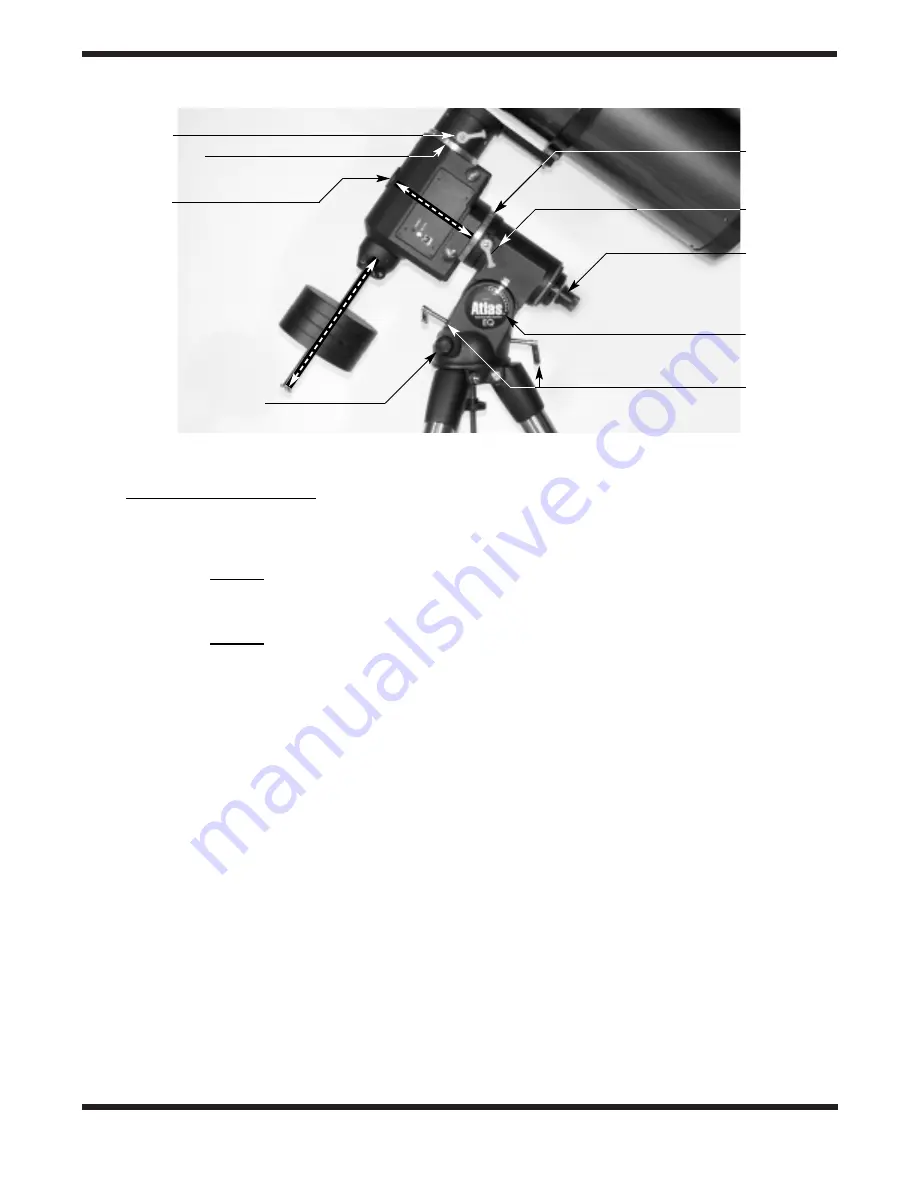
7
Telescope Focal Length (mm)
= Magnification
Eyepiece Focal Length (mm)
The Atlas 10 EQ has a focal length of 1200mm, which when
used with the supplied 25mm eyepiece yields a magnification of:
1200mm
= 48x
25mm
The magnification provided by the 10mm eyepiece is:
1200mm
= 120x
10mm
The maximum attainable magnification for a telescope is
directly related to how much light it can gather. The larger the
aperture, the more magnification is possible. In general a fig-
ure of 60x per inch of aperture is the maximum attainable for
most telescopes. Your Atlas 10 EQ has an aperture of 10
inches, so the maximum magnification would be about 600x.
This level of magnification assumes you have ideal conditions
for viewing.
Keep in mind that as you increase magnification, the bright-
ness of the object viewed will decrease; this is an inherent
principle of the laws of physics and cannot be avoided. If
magnification is doubled, an image appears four times dim-
mer. If magnification is tripled, image brightness is reduced by
a factor of nine!
Always start with your lowest power eyepiece and work your
way up. Start by centering the object being viewed in the 25mm
eyepiece. Then you may want to increase the magnification to
get a closer view. If the object is off-center (i.e., it is near the
edge of the field of view) you will lose it when you increase mag-
nification since the field of view will be narrower with the higher-
powered eyepiece. To change eyepieces, first loosen the secur-
ing thumbscrew on the focuser’s 1.25" adapter. Then carefully
lift the eyepiece out of the holder. Do not tug or pull the eyepiece
to the sides, as this will knock the telescope off its target.
Replace the eyepiece with the new one by sliding it gently into
the holder. Re-tighten the thumbscrew, and refocus for your new
magnification.
Using 2" eyepieces
The Atlas 10 EQ’s focuser is capable of accepting optional 2"
eyepieces. To use 2" eyepieces you must remove the 1.25"
adapter from the focuser by loosening the two thumbscrews
that hold it in place (Figure 4). Once this adapter is removed,
insert a 2" eyepiece into the focuser and use the same thumb-
screws to secure the larger eyepiece. 2" eyepieces typically
provide a wider field of view than 1.25" eyepieces.
6. Setting Up and Using the
Equatorial Mount
When you look at the night sky, you no doubt have noticed
that the stars appear to move slowly from east to west over
time. That apparent motion is caused by the Earth’s rotation
(from west to east). An equatorial mount (Figure 7) is
designed to compensate for that motion, allowing you to eas-
ily “track” the movement of astronomical objects, thereby
keeping them from drifting out of your telescope’s field of view
while you’re observing.
This is accomplished by slowly rotating the telescope on its
right ascension (R.A.) axis, using the built in motor drive. But
first the R.A. axis of the mount must be aligned with the Earth’s
rotational (polar) axis—a process called polar alignment.
Polar Alignment
For Northern Hemisphere observers, approximate polar
alignment is achieved by pointing the mount’s right ascension
axis at the North Star, or Polaris. It lies within 1° of the north
celestial pole (NCP), which is an extension of the Earth’s rota-
Figure 7.
The Atlas EQ Mount.
Dec. lock lever
Dec. setting circle
Front opening
Azimuth adjustment knobs (2)
R.A.
setting circle
R.A. lock lever
Polar axis
finder scope
Latitude scale
Latitude
adjustment
L-bolts
Rig
ht
As
cen
sio
n
(R
.A.)
ax
is
D
ec
lin
at
io
n
(D
ec
.)
a
xi
s
Rig
ht
As
cen
sio
n
(R.A.
) a
xis
Declination
(Dec
.) ax
is
































